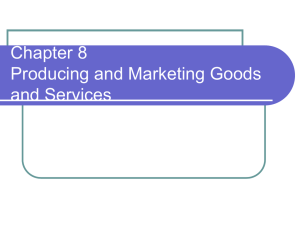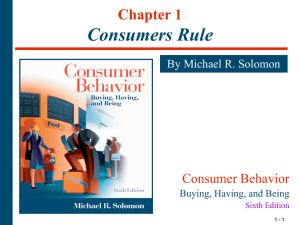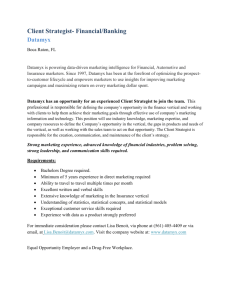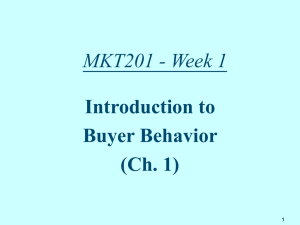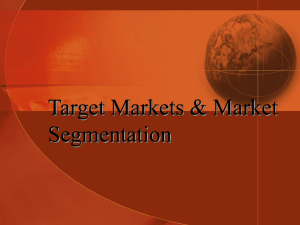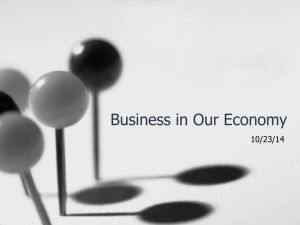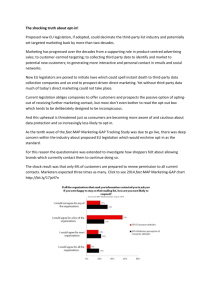Summary of Chapter
advertisement
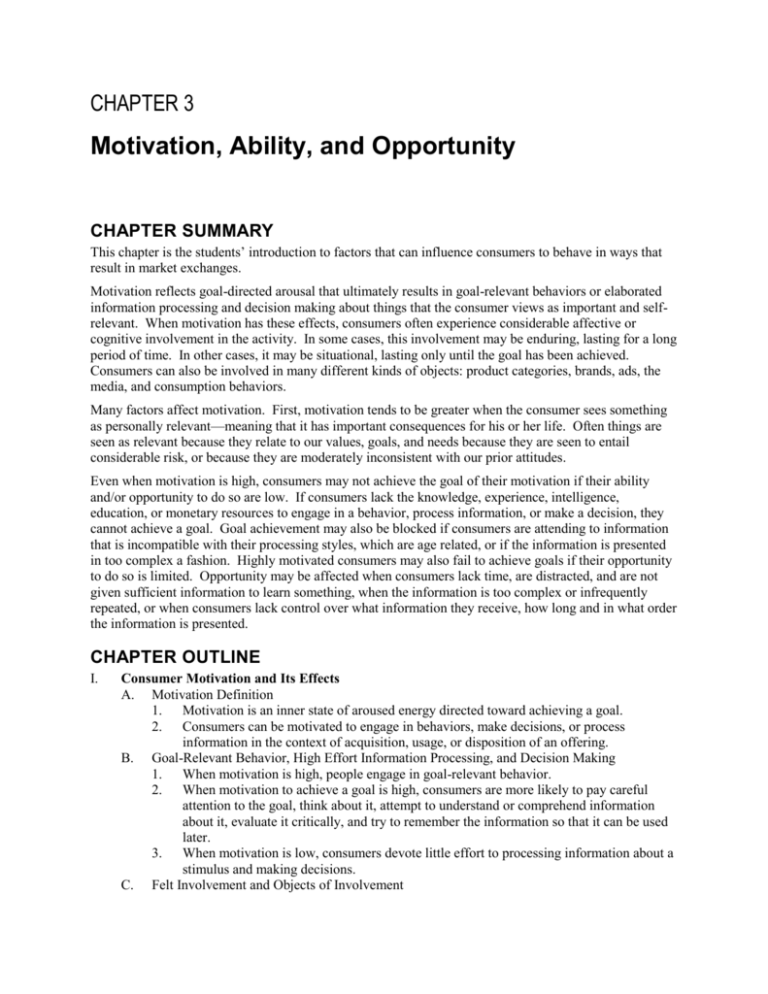
CHAPTER 3 Motivation, Ability, and Opportunity CHAPTER SUMMARY This chapter is the students’ introduction to factors that can influence consumers to behave in ways that result in market exchanges. Motivation reflects goal-directed arousal that ultimately results in goal-relevant behaviors or elaborated information processing and decision making about things that the consumer views as important and selfrelevant. When motivation has these effects, consumers often experience considerable affective or cognitive involvement in the activity. In some cases, this involvement may be enduring, lasting for a long period of time. In other cases, it may be situational, lasting only until the goal has been achieved. Consumers can also be involved in many different kinds of objects: product categories, brands, ads, the media, and consumption behaviors. Many factors affect motivation. First, motivation tends to be greater when the consumer sees something as personally relevant—meaning that it has important consequences for his or her life. Often things are seen as relevant because they relate to our values, goals, and needs because they are seen to entail considerable risk, or because they are moderately inconsistent with our prior attitudes. Even when motivation is high, consumers may not achieve the goal of their motivation if their ability and/or opportunity to do so are low. If consumers lack the knowledge, experience, intelligence, education, or monetary resources to engage in a behavior, process information, or make a decision, they cannot achieve a goal. Goal achievement may also be blocked if consumers are attending to information that is incompatible with their processing styles, which are age related, or if the information is presented in too complex a fashion. Highly motivated consumers may also fail to achieve goals if their opportunity to do so is limited. Opportunity may be affected when consumers lack time, are distracted, and are not given sufficient information to learn something, when the information is too complex or infrequently repeated, or when consumers lack control over what information they receive, how long and in what order the information is presented. CHAPTER OUTLINE I. Consumer Motivation and Its Effects A. Motivation Definition 1. Motivation is an inner state of aroused energy directed toward achieving a goal. 2. Consumers can be motivated to engage in behaviors, make decisions, or process information in the context of acquisition, usage, or disposition of an offering. B. Goal-Relevant Behavior, High Effort Information Processing, and Decision Making 1. When motivation is high, people engage in goal-relevant behavior. 2. When motivation to achieve a goal is high, consumers are more likely to pay careful attention to the goal, think about it, attempt to understand or comprehend information about it, evaluate it critically, and try to remember the information so that it can be used later. 3. When motivation is low, consumers devote little effort to processing information about a stimulus and making decisions. C. Felt Involvement and Objects of Involvement 1. II. Felt involvement is a psychological state that is an outcome generated by motivation. a) Enduring involvement exists when one is interested in an offering for a long period of time. b) Situational involvement exists when involvement with the offering is only temporary. c) Cognitive involvement means that the psychological state the consumer experiences is exhibited by interest in thinking about and processing information related to his or her goal. d) Affective involvement means that the psychological state the consumer experiences involves emotional energy and heightened feelings. 2. Consumers can be involved with product categories, brands, an advertisement about an offering, or even the medium in which the ad is placed. 3. Response involvement is the extent to which someone is involved with brand decisions or shopping behaviors. What Affects Motivation? A. Personal Relevance 1. Something is personally relevant to the extent that it has direct bearing on the self and has potentially significant consequences or implications for one’s life. 2. As things become more personally relevant, they are more likely to motivate us to behave, process information, or engage in effortful decision making about these things, and we will experience considerable involvement when buying, using, or disposing of them. 3. Marketers can increase a consumer’s motivation to process promotional materials by trying to make the information as personally relevant as possible. B. Values, Goals, and Needs 1. Values guide what we see as relevant to ourselves. 2. Goals reflect the objectives we would like to achieve given the current situation. a. Goal-attainment activities involve setting goals, planning, implementation and controlling relevant actions. 3. Needs reflect underlying inner forces that create tension in individuals when they are not held in equilibrium. Activation of the need produces goal-directed arousal in the individual. Maslow’s Hierarchy of Needs (from highest to lowest) (1). Physiological needs (food, water, and sleep) (2). Safety needs (shelter, protection, and security) (3). Social needs (affection, friendship, and acceptance) (4). Egoistic needs (prestige, success, accomplishment, and self-esteem) (5). Self-actualization needs (self-fulfillment and enriching experiences) (6). Maslow’s hierarchy has been criticized as overly simplistic as needs may not always be satisfied “in order” and the ordering of the needs may be culturally influenced. b) Social and nonsocial needs (1). Social needs are externally directed and relate to other individuals (e.g., the need for esteem, succor, and modeling). (2). Nonsocial needs are those whose achievement is not based on other people (e.g., the need for sleep, novelty, control, and understanding). c) Functional, symbolic, and hedonic needs (1). Functional needs are those that motivate the search for products that solve consumption-related problems (like a need for safety). (2). Symbolic needs are those that reflect self-enhancement, role position, group membership, or ego identification. (3). Hedonic needs reflect sensory pleasure (like a need for sex, play, novelty, cognitive stimulation, or sensory stimulation). d) Needs for cognition and stimulation (1). Those who have a high need for cognition are more likely to process information actively and engage in cognitive processing during decision making as compared to those who have a low need for cognition. (2). Those who have a high optimum stimulation level (OSL) need more sensory stimulation; have been found to be very involved in shopping and seeking information about brands; and show higher involvement in ads than those with a lower OSL. Characteristics of Needs a) Needs are dynamic, constantly changing, and never fully satisfied. b) Needs exist in a hierarchy. c) Needs can be aroused by internal or external cues. d) Needs can conflict with one another. (1). Approach-avoidance conflict occurs when a given behavior is seen as both desirable and undesirable because it satisfies some of the consumer’s needs but fails to satisfy others. (2). Approach-approach conflict occurs when the consumer faces the task of choosing among two or more equally desirable options that fulfill different needs. (3). Avoidance-avoidance conflict occurs when the consumer faces the task of choosing between equally undesirable options. Identifying Needs a) Identifying consumers’ needs is useful to marketers, but doing so is not easy. b) Observing and interpreting behavior is risky due to cultural differences. c) Methods like non-directed projection ask consumers to interpret ambiguous stimuli (like cartoons, word associations, sentence completions). These techniques often allow consumers to reveal their needs by using their own words to express thoughts about a topic. a) 4. 5. 6. Marketing Implications a) Needs can be used to segment markets. b) Marketers can attempt to create new needs. c) Marketers can identify unfulfilled needs or create alternatives that are more satisfying. d) Marketers can resolve need conflicts. e) Marketers can increase the likelihood that consumers will engage in desired behavior by suggesting that their product can fulfill a need. C. Perceived Risk 1. Describing Perceived Risk a) Perceived risk is defined as the extent to which the consumer is uncertain about the consequences of an action (buying, using, or disposing of an offering). 2. Types of Perceived Risk a) Performance risk reflects uncertainty about whether the product or service will perform as expected. b) Financial risk reflects consumers’ concerns about their monetary investment in a product or service. c) Physical (or safety) risk refers to the potential harm that a product or service might pose to one’s safety. d) Social risk refers to the potential harm to one’s social standing that may arise from buying, using, or disposing of an offering. e) Psychological risk reflects consumers’ concern over the extent to which a product or service fits with the way they perceive themselves. f) Time risk reflects uncertainties over the length of time consumers must invest in buying, using, or disposing of the product or service. 3. Risk and Involvement a) Involvement can be classified by risk level. The higher the risk, the higher the involvement. b) Since high risk is uncomfortable, consumers are likely to attempt to reduce or resolve risk by gathering more information or by relying on brand loyalty. 4. Marketing Implications a) When perceived risk is high, marketers can either reduce uncertainty or reduce the perceived consequences of failure. b) When perceived risk is low, marketers have to increase risk perceptions to make emotional appeals more convincing. D. Inconsistency with Attitudes 1. Consumers tend to be motivated to process messages that are moderately inconsistent with existing knowledge or attitudes, because they are perceived as moderately threatening or uncomfortable. The consumer is motivated to remove or understand this inconsistency. 2. Consumers are less motivated to process information that is highly inconsistent with their prior attitudes. III. Consumer Ability: Resources to Act A. Ability is defined as the extent to which consumers have the necessary resources (knowledge, intelligence, and money) to make the outcome happen. B. Product Knowledge and Experience 1. Consumers who have more experience with an issue or product (experts) are able to process more complex information about it than those who have less experience (novices). Experts process more extensively when presented with attribute information (“what it does”), whereas novices process benefit information (“what it does for me”) more extensively. C. Cognitive Style 1. Consumers differ in cognitive styles. Some prefer visual information whereas others prefer verbal information. 2. Differences in cognitive complexity suggest that cognitively complex consumers are more likely to engage in complex processing, accepting a greater amount of diverse information when making a decision. D. Intelligence, Education, and Age 1. Higher levels of intelligence and education will enhance the consumer’s ability to process information that is more complex and to make decisions. 2. Old age has been associated with a decline in certain cognitive skills and thus reduced ability to process information. E. Money 1. The lack of money constrains consumers who might otherwise have the motivation to engage in monetary exchanges with marketers. F. Marketing Implications 1. Marketers should be sure the target audience has enough prior knowledge to process marketing communications. 2. Marketers should match communications with consumers’ knowledge and processing styles. 3. Marketers can provide monetary aid to facilitate first time and repeat buying. IV. Consumer Opportunity A. This factor reflects the extent to which consumers have the opportunity to process actions. B. Time 1. Time can affect the opportunity to process information, make decisions, and perform certain behaviors. C. Distraction 1. Distraction refers to any aspect of the processing situation that can divert consumers’ attention away from the processing of a message. a) Direct interference includes talking while a consumer is viewing an ad. b) Background factors in an ad such as music or attractive models could distract consumers from the central message. D. Amount of Information 1. Too little or too much information can affect the processing opportunity. E. Complexity of Information 1. Information’s complexity (the extent to which it is technical, quantitative, or visual in nature) decreases the opportunity for consumers to process it. F. Repetition of Information 1. Repetition of information enhances consumers’ opportunity to process information. G. Control of Information 1. Consumers remember more when they control the flow of information by determining a) What information is presented? b) How long it is presented c) In what order information is presented H. Marketing Implications 1. Marketers should repeat marketing communications and make them easy to process. 2. Marketers should reduce time-pressured decision-making. 3. Marketers should reduce the amount of time needed to buy or use a product. 2. 4. Marketers should provide consumers with enough information to enhance consumers’ abilities to process information, make decisions, and engage in consumer behavior. QUESTIONS FOR REVIEW AND DISCUSSION 1. How does perceived risk affect personal relevance, and what are six types of perceived risk? 2. Identify some of the elements that contribute to consumer opportunity for processing information and making decisions. 3. Explain how motivation influences consumer behavior. 4. Discuss the three factors that determine the amount of effort and involvement consumers put into searching for information, making choices, and judging whether an experience is satisfactory.

